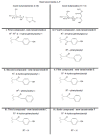Dandelion (Taraxacum officinale L.) as a Source of Biologically Active Compounds Supporting the Therapy of Co-Existing Diseases in Metabolic Syndrome
- PMID: 36140985
- PMCID: PMC9498421
- DOI: 10.3390/foods11182858
Dandelion (Taraxacum officinale L.) as a Source of Biologically Active Compounds Supporting the Therapy of Co-Existing Diseases in Metabolic Syndrome
Abstract
Nowadays, many people are struggling with obesity, type 2 diabetes, and atherosclerosis, which are called the scourge of the 21st century. These illnesses coexist in metabolic syndrome, which is not a separate disease entity because it includes several clinical conditions such as central (abdominal) obesity, elevated blood pressure, and disorders of carbohydrate and fat metabolism. Lifestyle is considered to have an impact on the development of metabolic syndrome. An unbalanced diet, the lack of sufficient physical activity, and genetic factors result in the development of type 2 diabetes and atherosclerosis, which significantly increase the risk of cardiovascular complications. The treatment of metabolic syndrome is aimed primarily at reducing the risk of the development of coexisting diseases, and the appropriate diet is the key factor in the treatment. Plant raw materials containing compounds that regulate lipid and carbohydrate metabolism in the human body are investigated. Dandelion (Taraxacum officinale F.H. Wigg.) is a plant, the consumption of which affects the regulation of lipid and sugar metabolism. The growth of this plant is widely spread in Eurasia, both Americas, Africa, New Zealand, and Australia. The use and potential of this plant that is easily accessible in the world in contributing to the treatment of type 2 diabetes and atherosclerosis have been proved by many studies.
Keywords: anti-diabetes; antioxidant activity; antiplatelet activity; dandelion; hypolipidemic effect; metabolic syndrome.
Conflict of interest statement
The authors declare no conflict of interest.
Figures




Similar articles
-
Hypolipidemic and antioxidant effects of dandelion (Taraxacum officinale) root and leaf on cholesterol-fed rabbits.Int J Mol Sci. 2010 Jan 6;11(1):67-78. doi: 10.3390/ijms11010067. Int J Mol Sci. 2010. PMID: 20162002 Free PMC article.
-
The potential of dandelion in the fight against gastrointestinal diseases: A review.J Ethnopharmacol. 2022 Jul 15;293:115272. doi: 10.1016/j.jep.2022.115272. Epub 2022 Apr 8. J Ethnopharmacol. 2022. PMID: 35405251 Review.
-
New Perspectives on the Effect of Dandelion, Its Food Products and Other Preparations on the Cardiovascular System and Its Diseases.Nutrients. 2022 Mar 24;14(7):1350. doi: 10.3390/nu14071350. Nutrients. 2022. PMID: 35405963 Free PMC article. Review.
-
A beta-glucosidase of an insect herbivore determines both toxicity and deterrence of a dandelion defense metabolite.Elife. 2021 Oct 11;10:e68642. doi: 10.7554/eLife.68642. Elife. 2021. PMID: 34632981 Free PMC article.
-
The composition and vascular/antioxidant properties of Taraxacum officinale flower water syrup in a normal-fat diet using an obese rat model.J Ethnopharmacol. 2021 Jan 30;265:113393. doi: 10.1016/j.jep.2020.113393. Epub 2020 Sep 14. J Ethnopharmacol. 2021. PMID: 32941970
Cited by
-
Exploring the Medicinal Potential of Taraxacum Kok-Saghyz (TKS) Using Widely Targeted Metabolomics.Metabolites. 2025 May 3;15(5):306. doi: 10.3390/metabo15050306. Metabolites. 2025. PMID: 40422883 Free PMC article.
-
A comprehensive analysis of chemical and biological pollutants (natural and anthropogenic origin) of soil and dandelion (Taraxacum officinale) samples.PLoS One. 2023 Jan 20;18(1):e0280810. doi: 10.1371/journal.pone.0280810. eCollection 2023. PLoS One. 2023. PMID: 36662824 Free PMC article.
-
Nutraceuticals and the Network of Obesity Modulators.Nutrients. 2022 Dec 1;14(23):5099. doi: 10.3390/nu14235099. Nutrients. 2022. PMID: 36501129 Free PMC article. Review.
-
The Biological Active Substances of Taraxacum officinale and Arctium lappa from the Siberian Federal District.Int J Mol Sci. 2024 Mar 13;25(6):3263. doi: 10.3390/ijms25063263. Int J Mol Sci. 2024. PMID: 38542237 Free PMC article.
-
Effects of Taraxaci Herba (Dandelion) on Testosterone Propionate-Induced Benign Prostatic Hyperplasia in Rats.Nutrients. 2024 Apr 17;16(8):1189. doi: 10.3390/nu16081189. Nutrients. 2024. PMID: 38674879 Free PMC article.
References
-
- Alberti K.G., Zimmet P.Z. Definition, diagnosis and classification of diabetes mellitus and its complications. Part 1: Diagnosis and classification of diabetes mellitus provisional report of a WHO consultation. Diabet. Med. 1998;15:539–553. doi: 10.1002/(SICI)1096-9136(199807)15:7<539::AID-DIA668>3.0.CO;2-S. - DOI - PubMed
-
- Alberti K.G., Zimmet P.Z., Shaw J., Grundy S.M. International Diabetes Federation 2006: The IDF Consensus Worldwide Definition of the Metabolic Syndrome. [(accessed on 10 March 2016)]. Available online: http://www.idf.org/webdata/docs/IDF_Meta_def_final.pdf.
-
- Expert Panel on Detection, Evaluation, and Treatment of High Blood Cholesterol in Adults Executive Summary of the Third Report of the National Cholesterol Education Program (NCEP) expert Panel on detection, evaluation, and treatment of high blood cholesterol in adults (Adult Treatment Panel III) JAMA. 2001;285:2486–2497. doi: 10.1001/jama.285.19.2486. - DOI - PubMed
Publication types
LinkOut - more resources
Full Text Sources

